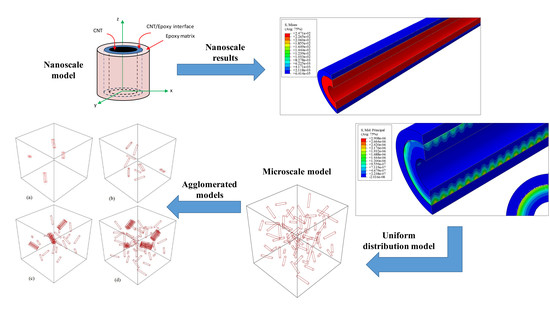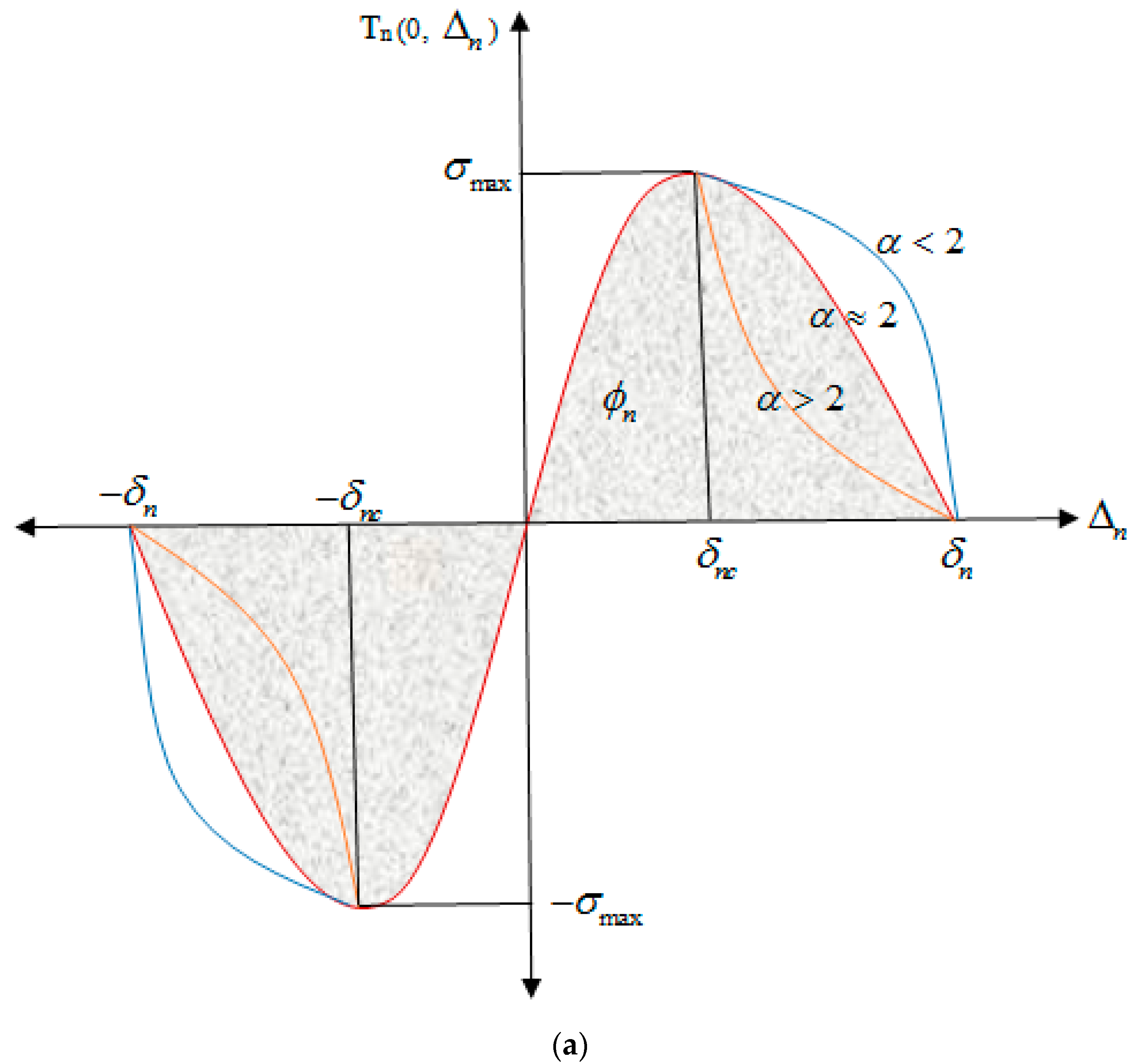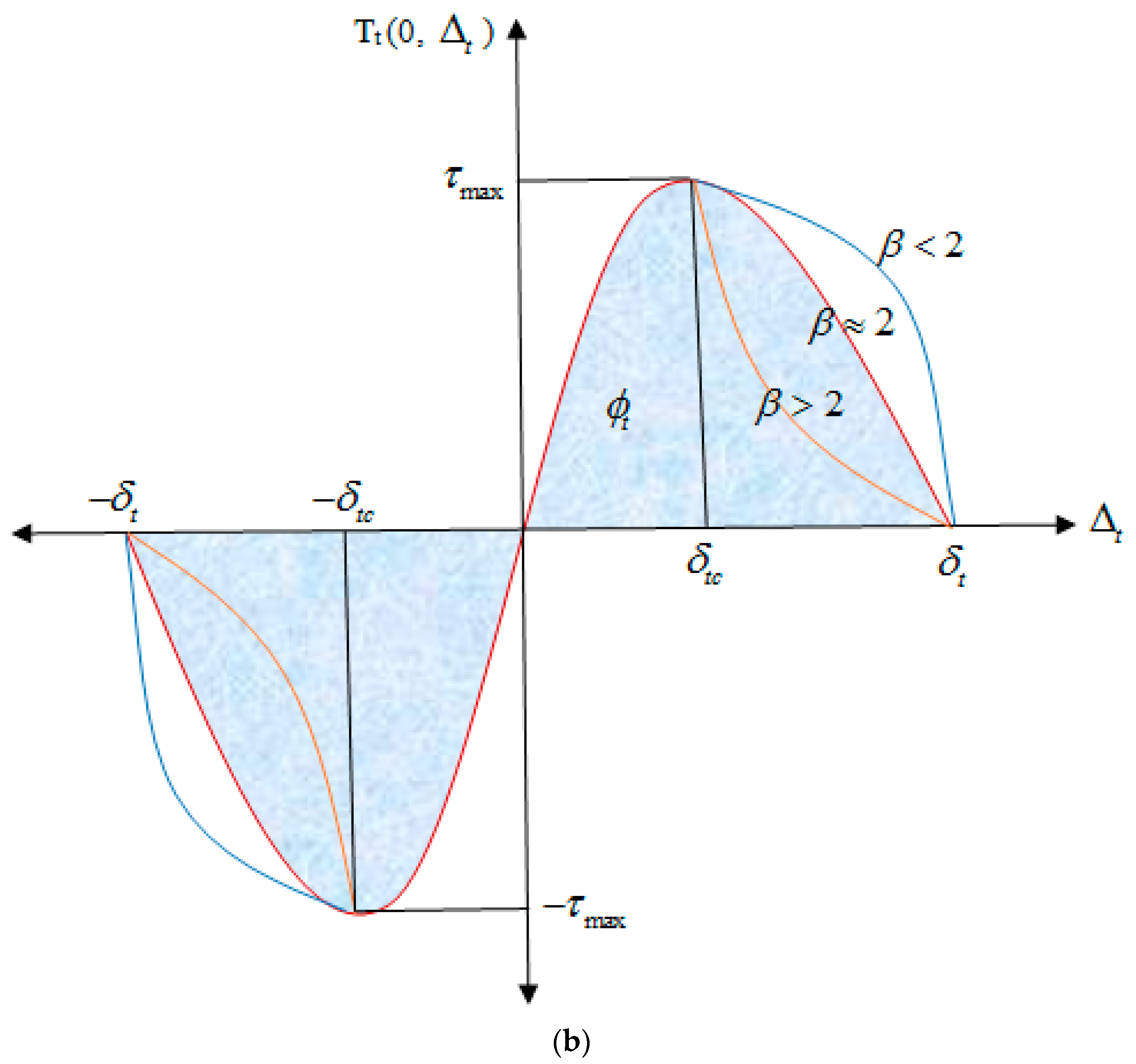Using the Equivalent Fiber Approach in Two-Scale Modeling of the Elastic Behavior of Carbon Nanotube/Epoxy Nanocomposite
Abstract
1. Introduction
2. Nanocomposite Modeling
2.1. Interface
2.2. Potential Model
2.3. Equivalent Fiber
3. Simulation of Nanocomposite Behavior
3.1. Equivalent Fiber Simulation
3.2. RVE Simulation
3.3. Simulation of CNTs Agglomeration
4. Experimental Studies
5. Result and Discussion
6. Conclusions
- The PPR model is reliable for the modeling of interface in nanocomposites.
- The results of modeling at the nanoscale showed that the EF length and the matrix thickness has a diminishing effect on elastic behavior of EF for EF length more than 300 nm. Due to the limitations in simulation of RVE, the minimum length of EF is considered 300 nm.
- The results from this study have the proximity to experimental results and they predict more accurately than the calculated ones by Halpin–Tsai equation, especially at higher CNT loading.
- Although some methods were used to disperse CNTs in the production of specimens, the increase in volume fraction has increased the differences between the numerical and experimental results. However, the maximum difference in Young’s modulus from the full dispersion model relative to experiment at the volume fraction of 1% is two-third lower than that between Halpin–Tsai equation and experiments.
- The clustering of equivalent fibers increases the heterogeneity of the RVE, and by increasing the interaction between the equivalent fibers, their contribution to interacting with the environment is low, thereby reducing the properties of the nanocomposite.
- The agglomeration of CNT in the nanocomposite degrades its effective elastic properties and the effective elastic properties decrease with the increase of the CNT agglomerate size.
Author Contributions
Funding
Acknowledgments
Conflicts of Interest
Appendix A
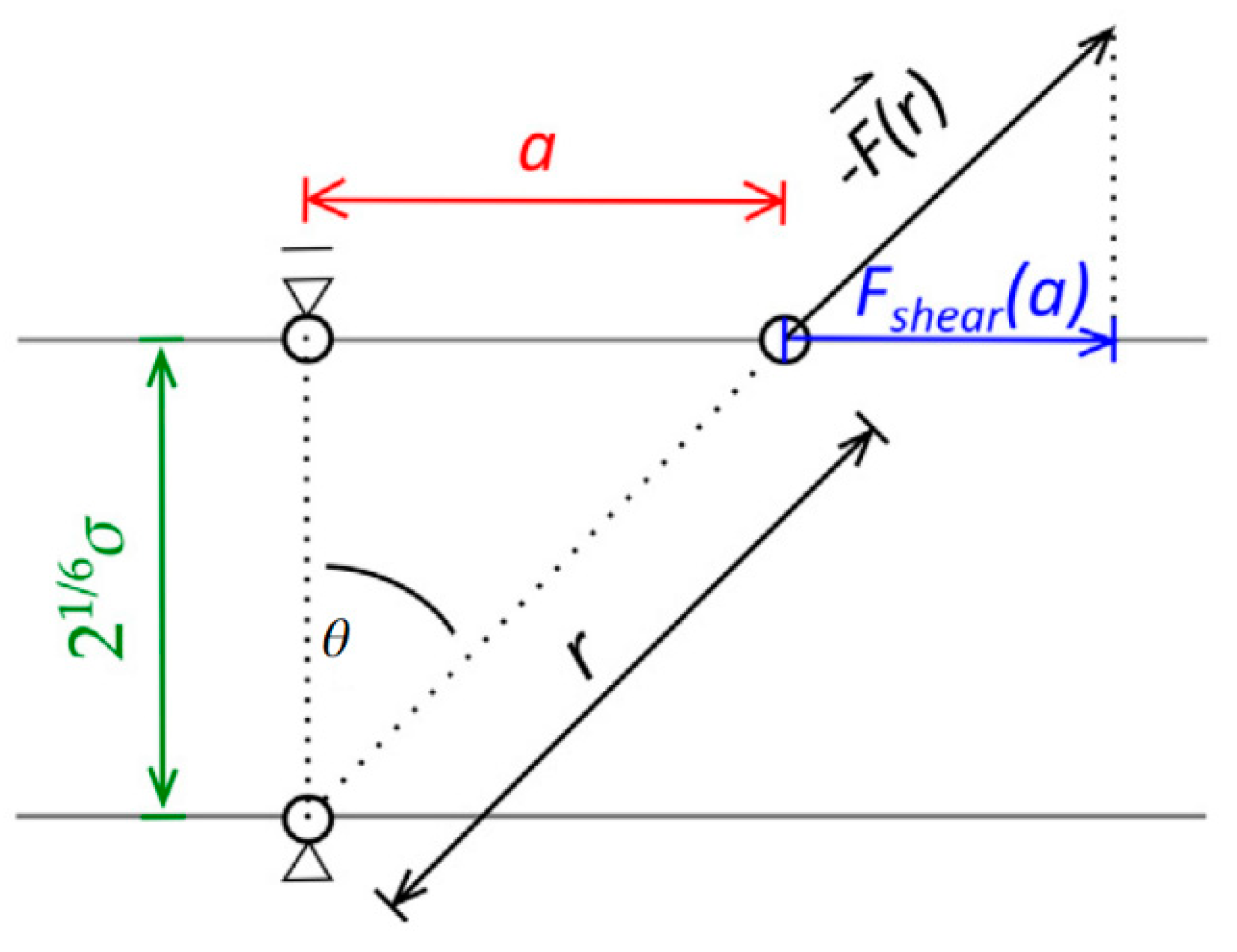
Appendix B
References
- Plueddemann, E.P. Interfaces in Polymer Matrix Composites: Composite Materials; Elsevier: New York, NY, USA, 2016; Volume 6. [Google Scholar]
- Kausar, A.; Rafique, I.; Muhammad, B. Review of applications of polymer/carbon nanotubes and epoxy/cnt composites. Polym. Plast. Technol. Eng. 2016, 55, 1167–1191. [Google Scholar] [CrossRef]
- Ma, P.-C.; Siddiqui, N.A.; Marom, G.; Kim, J.-K. Dispersion and functionalization of carbon nanotubes for polymer-based nanocomposites: A review. Compos. Part A 2010, 41, 1345–1367. [Google Scholar] [CrossRef]
- Gu, J.; Yang, X.; Li, C.; Kou, K. Synthesis of cyanate ester microcapsules via solvent evaporation technique and its application in epoxy resins as a healing agent. Ind. Eng. Chem. Res. 2016, 55, 10941–10946. [Google Scholar] [CrossRef]
- Lei, L.; Shan, J.; Hu, J.; Liu, X.; Zhao, J.; Tong, Z. Co-curing effect of imidazole grafting graphene oxide synthesized by one-pot method to reinforce epoxy nanocomposites. Compos. Sci. Technol. 2016, 128, 161–168. [Google Scholar] [CrossRef]
- Wang, F.; Drzal, L.T.; Qin, Y.; Huang, Z. Enhancement of fracture toughness, mechanical and thermal properties of rubber/epoxy composites by incorporation of graphene nanoplatelets. Compos. Part A 2016, 87, 10–22. [Google Scholar] [CrossRef]
- Halary, J.L. Structure-property relationships in epoxy–amine networks of well-controlled architecture. High Perform. Polym. 2000, 12, 141–153. [Google Scholar] [CrossRef]
- Rana, D.; Sauvant, V.; Halary, J. Molecular analysis of yielding in pure and antiplasticized epoxy–amine thermosets. J. Mater. Sci. 2002, 37, 5267–5274. [Google Scholar] [CrossRef]
- Domun, N.; Hadavinia, H.; Zhang, T.; Sainsbury, T.; Liaghat, G.; Vahid, S. Improving the fracture toughness and the strength of epoxy using nanomaterials–a review of the current status. Nanoscale 2015, 7, 10294–10329. [Google Scholar] [CrossRef] [PubMed]
- Andrews, R.; Weisenberger, M. Carbon nanotube polymer composites. Curr. Opin. Solid State Mater. Sci. 2004, 8, 31–37. [Google Scholar] [CrossRef]
- Gu, J.; Liang, C.; Zhao, X.; Gan, B.; Qiu, H.; Guo, Y.; Yang, X.; Zhang, Q.; Wang, D.-Y. Highly thermally conductive flame-retardant epoxy nanocomposites with reduced ignitability and excellent electrical conductivities. Compos. Sci. Technol. 2017, 139, 83–89. [Google Scholar] [CrossRef]
- Manchado, M.L.; Valentini, L.; Biagiotti, J.; Kenny, J. Thermal and mechanical properties of single-walled carbon nanotubes–polypropylene composites prepared by melt processing. Carbon 2005, 43, 1499–1505. [Google Scholar] [CrossRef]
- Quaresimin, M.; Salviato, M.; Zappalorto, M. Strategies for the assessment of nanocomposite mechanical properties. Compos. Part B 2012, 43, 2290–2297. [Google Scholar] [CrossRef]
- Odegard, G.M.; Gates, T.S.; Nicholson, L.M.; Wise, K.E. Equivalent-continuum modeling of nano-structured materials. Compos. Sci. Technol. 2002, 62, 1869–1880. [Google Scholar] [CrossRef]
- Wan, H.; Delale, F.; Shen, L. Effect of CNT length and cnt-matrix interphase in carbon nanotube (cnt) reinforced composites. Mech. Res. Commun. 2005, 32, 481–489. [Google Scholar] [CrossRef]
- Liu, Y.; Chen, X. Evaluations of the effective material properties of carbon nanotube-based composites using a nanoscale representative volume element. Mech. Mater. 2003, 35, 69–81. [Google Scholar] [CrossRef]
- Chen, X.; Liu, Y. Square representative volume elements for evaluating the effective material properties of carbon nanotube-based composites. Comput. Mater. Sci. 2004, 29, 1–11. [Google Scholar] [CrossRef]
- Fereidoon, A.; Saeedi, E.; Ahmadimoghadam, B. Comparison between different finite element methods for foreseeing the elastic properties of carbon nanotube reinforced epoxy resin composite. In Proceedings of the World Congress on Engineering, London, UK, 2–4 July 2008; Volume 2, pp. 1381–1385. [Google Scholar]
- Shokrieh, M.M.; Rafiee, R. Prediction of mechanical properties of an embedded carbon nanotube in polymer matrix based on developing an equivalent long fiber. Mech. Res. Commun. 2010, 37, 235–240. [Google Scholar] [CrossRef]
- Shojaie, M.; Golestanian, H. Effects of interface characteristics on mechanical properties of carbon nanotube reinforced polymer composites. Mater. Sci. Technol. 2011, 27, 916–922. [Google Scholar] [CrossRef]
- Joshi, U.A.; Sharma, S.C.; Harsha, S. Effect of carbon nanotube orientation on the mechanical properties of nanocomposites. Compos. Part B 2012, 43, 2063–2071. [Google Scholar] [CrossRef]
- Deng, L.; Eichhorn, S.J.; Kao, C.-C.; Young, R.J. The effective Young’s modulus of carbon nanotubes in composites. ACS Appl. Mater. Interfaces 2011, 3, 433–440. [Google Scholar] [CrossRef] [PubMed]
- Peng, R.; Zhou, H.; Wang, H.; Mishnaevsky, L., Jr. Modeling of nano-reinforced polymer composites: Microstructure effect on Young’s modulus. Comput. Mater. Sci. 2012, 60, 19–31. [Google Scholar] [CrossRef]
- Zuberi, M.J.S.; Esat, V. Investigating the mechanical properties of single walled carbon nanotube reinforced epoxy composite through finite element modelling. Compos. Part B 2015, 71, 1–9. [Google Scholar] [CrossRef]
- Subramanian, N.; Rai, A.; Chattopadhyay, A. Atomistically derived cohesive behavior of interphases in carbon fiber reinforced cnt nanocomposites. Carbon 2017, 117, 55–64. [Google Scholar] [CrossRef]
- Zhigilei, L.V.; Volkov, A.N.; Dongare, A.M. Computational study of nanomaterials: From large-scale atomistic simulations to mesoscopic modeling. In Encyclopedia of Nanotechnology; Springer: Dordrecht, The Netherlands, 2012; pp. 470–480. [Google Scholar]
- Hu, Z.; Arefin, M.R.H.; Yan, X.; Fan, Q.H. Mechanical property characterization of carbon nanotube modified polymeric nanocomposites by computer modeling. Compos. Part B 2014, 56, 100–108. [Google Scholar] [CrossRef]
- Liu, B.; Huang, Y.; Jiang, H.; Qu, S.; Hwang, K. The atomic-scale finite element method. Comput. Methods Appl. Mech. Eng. 2004, 193, 1849–1864. [Google Scholar] [CrossRef]
- Liu, L.; Barber, A.H.; Nuriel, S.; Wagner, H.D. Mechanical properties of functionalized single-walled carbon nanotube/poly (vinyl alcohol) nanocomposites. Adv. Funct. Mater. 2005, 15, 975–980. [Google Scholar] [CrossRef]
- Chen, G.-X.; Kim, H.-S.; Park, B.H.; Yoon, J.-S. Multiwalled carbon nanotubes reinforced nylon 6 composites. Polymer 2006, 47, 4760–4767. [Google Scholar] [CrossRef]
- Shokrieh, M.; Mahdavi, S. Micromechanical model to evaluate the effects of dimensions and interphase region on the elastic modulus of CNT/polymer composites. Modares Mech. J. 2011, 11, 13–25. [Google Scholar]
- Anderson, T.L.; Anderson, T. Fracture Mechanics: Fundamentals and Applications; CRC Press, Taylor & Francis Group: Boca Raton, FL, USA, 2005. [Google Scholar]
- Bahr, J.L.; Tour, J.M. Covalent chemistry of single-wall carbon nanotubes. J. Mater. Chem. 2002, 12, 1952–1958. [Google Scholar] [CrossRef]
- Gou, J.; Minaie, B.; Wang, B.; Liang, Z.; Zhang, C. Computational and experimental study of interfacial bonding of single-walled nanotube reinforced composites. Comput. Mater. Sci. 2004, 31, 225–236. [Google Scholar] [CrossRef]
- Weidt, D.; Figiel, L. Effect of cnt waviness and van der Waals interaction on the nonlinear compressive behaviour of epoxy/cnt nanocomposites. Compos. Sci. Technol. 2015, 115, 52–59. [Google Scholar] [CrossRef]
- Zakeri, M.; Shayanmehr, M.; Shokrieh, M. Interface modeling of nanotube reinforced nanocomposites by using multi-scale modeling method. Modares Mech. Eng. 2013, 12, 1–11. [Google Scholar]
- Ayatollahi, M.; Shadlou, S.; Shokrieh, M. Multiscale modeling for mechanical properties of carbon nanotube reinforced nanocomposites subjected to different types of loading. Compos. Struct. 2011, 93, 2250–2259. [Google Scholar] [CrossRef]
- Jiang, L.; Huang, Y.; Jiang, H.; Ravichandran, G.; Gao, H.; Hwang, K.; Liu, B. A cohesive law for carbon nanotube/polymer interfaces based on the van der waals force. J. Mech. Phys. Solids 2006, 54, 2436–2452. [Google Scholar] [CrossRef]
- Tan, H.; Jiang, L.; Huang, Y.; Liu, B.; Hwang, K. The effect of van der waals-based interface cohesive law on carbon nanotube-reinforced composite materials. Compos. Sci. Technol. 2007, 67, 2941–2946. [Google Scholar] [CrossRef]
- Park, K.; Paulino, G.H.; Roesler, J.R. A unified potential-based cohesive model of mixed-mode fracture. J. Mech. Phys. Solids 2009, 57, 891–908. [Google Scholar] [CrossRef]
- Spring, D.W.; Paulino, G.H. A growing library of three-dimensional cohesive elements for use in abaqus. Eng. Fract. Mech. 2014, 126, 190–216. [Google Scholar] [CrossRef]
- Spring, D.W.; Paulino, G.H. Computational homogenization of the debonding of particle reinforced composites: The role of interphases in interfaces. Comput. Mater. Sci. 2015, 109, 209–224. [Google Scholar] [CrossRef]
- Born, M.; Huang, K. Dynamical Theory of Crystal Lattices; Clarendon Press: Oxford, UK, 1954. [Google Scholar]
- Zhang, P.; Huang, Y.; Gao, H.; Hwang, K. Fracture nucleation in single-wall carbon nanotubes under tension: A continuum analysis incorporating interatomic potentials. J. Appl. Mech. 2002, 69, 454–458. [Google Scholar] [CrossRef]
- Glaucio, H. Paulino on the Web. Available online: https://paulino.ce.gatech.edu/PPR_tutorial.html (accessed on 17 June 2017).
- Kundalwal, S.; Meguid, S. Multiscale modeling of regularly staggered carbon fibers embedded in nano-reinforced composites. Eur. J. Mech. A-Solids 2017, 64, 69–84. [Google Scholar] [CrossRef]
- Alian, A.; Kundalwal, S.; Meguid, S. Interfacial and mechanical properties of epoxy nanocomposites using different multiscale modeling schemes. Compos. Struct. 2015, 131, 545–555. [Google Scholar] [CrossRef]
- Alian, A.; Kundalwal, S.; Meguid, S. Multiscale modeling of carbon nanotube epoxy composites. Polymer 2015, 70, 149–160. [Google Scholar] [CrossRef]
- Tserpes, K.; Chanteli, A. Parametric numerical evaluation of the effective elastic properties of carbon nanotube-reinforced polymers. Compos. Struct. 2013, 99, 366–374. [Google Scholar] [CrossRef]
- US Research Nanomaterials, Inc. Available online: us-nano.com (accessed on 5 May 2017).
- Shokrieh, M.M.; Rafiee, R. Stochastic multi-scale modeling of CNT/polymer composites. Comput. Mater. Sci. 2010, 50, 437–446. [Google Scholar] [CrossRef]
- Zeng, Q.; Yu, A.; Lu, G. Multiscale modeling and simulation of polymer nanocomposites. Prog. Polym. Sci. 2008, 33, 191–269. [Google Scholar] [CrossRef]
- Li, C.; Chou, T.-W. Multiscale modeling of compressive behavior of carbon nanotube/polymer composites. Compos. Sci. Technol. 2006, 66, 2409–2414. [Google Scholar] [CrossRef]
- Ma, P.-C.; Mo, S.-Y.; Tang, B.-Z.; Kim, J.-K. Dispersion, interfacial interaction and re-agglomeration of functionalized carbon nanotubes in epoxy composites. Carbon 2010, 48, 1824–1834. [Google Scholar] [CrossRef]
- Liu, C.-X.; Choi, J.-W. Improved dispersion of carbon nanotubes in polymers at high concentrations. Nanomaterials 2012, 2, 329–347. [Google Scholar] [CrossRef] [PubMed]
- Bhattacharya, M. Polymer nanocomposites—A comparison between carbon nanotubes, graphene, and clay as nanofillers. Materials 2016, 9, 262. [Google Scholar] [CrossRef] [PubMed]
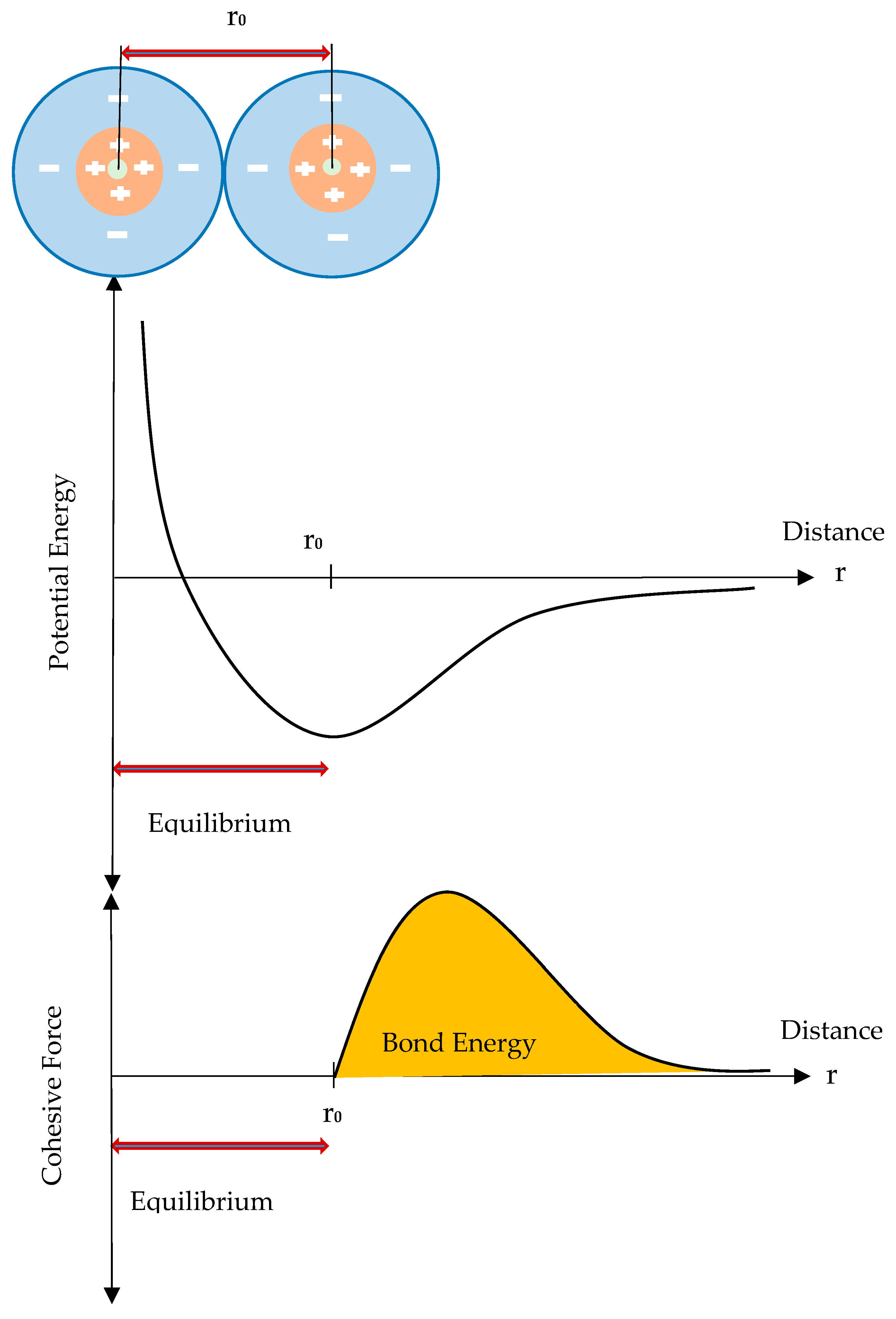
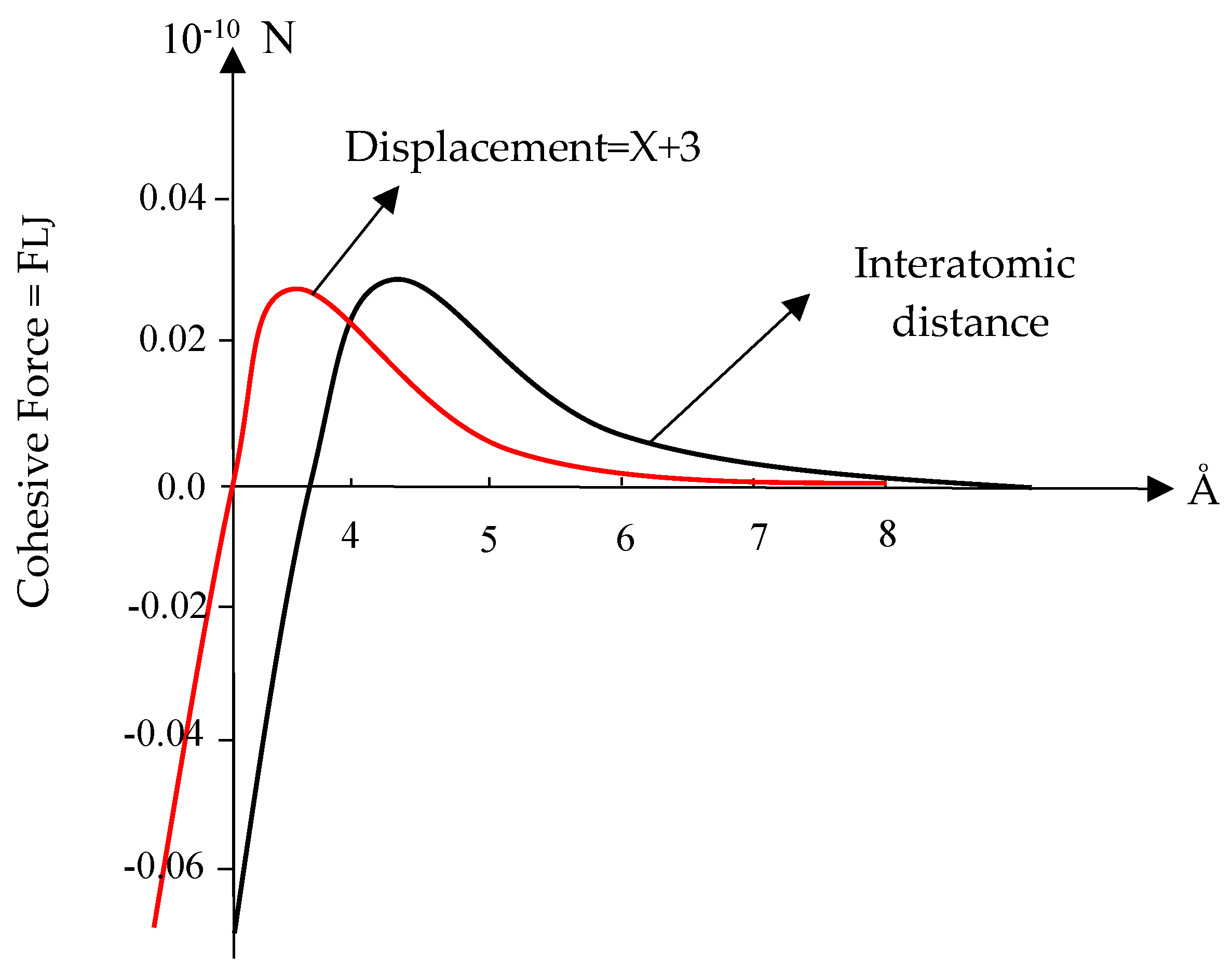
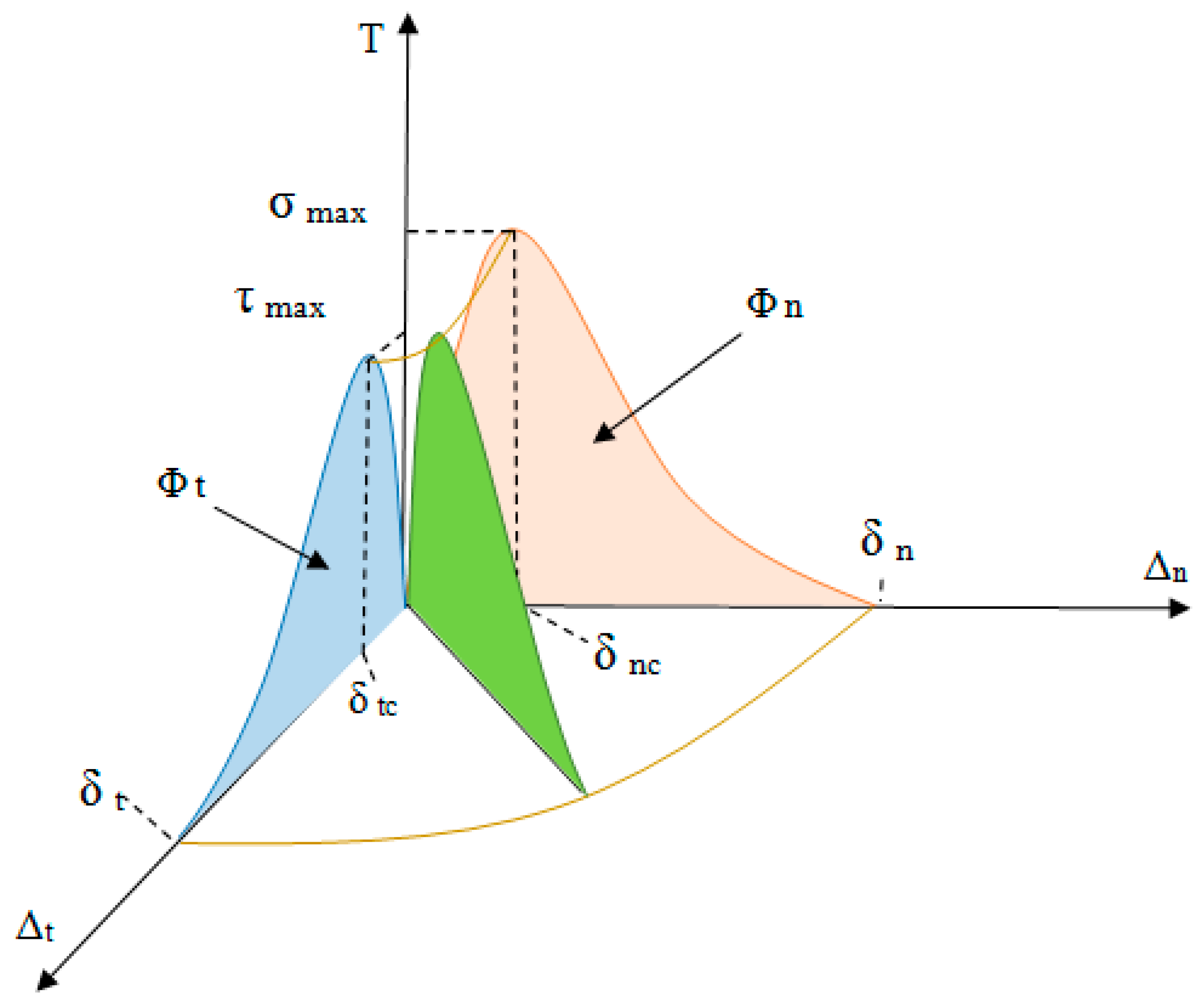
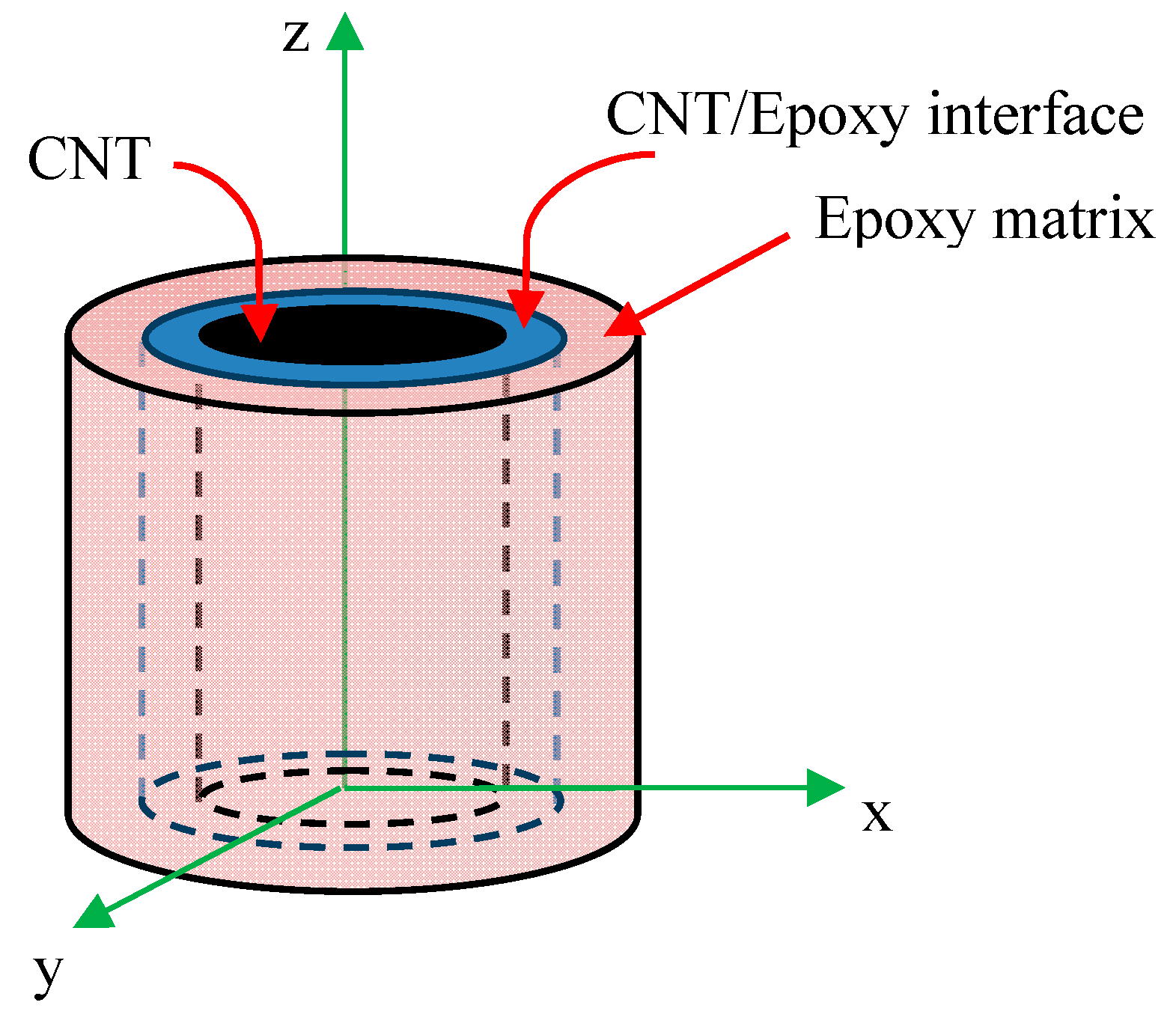
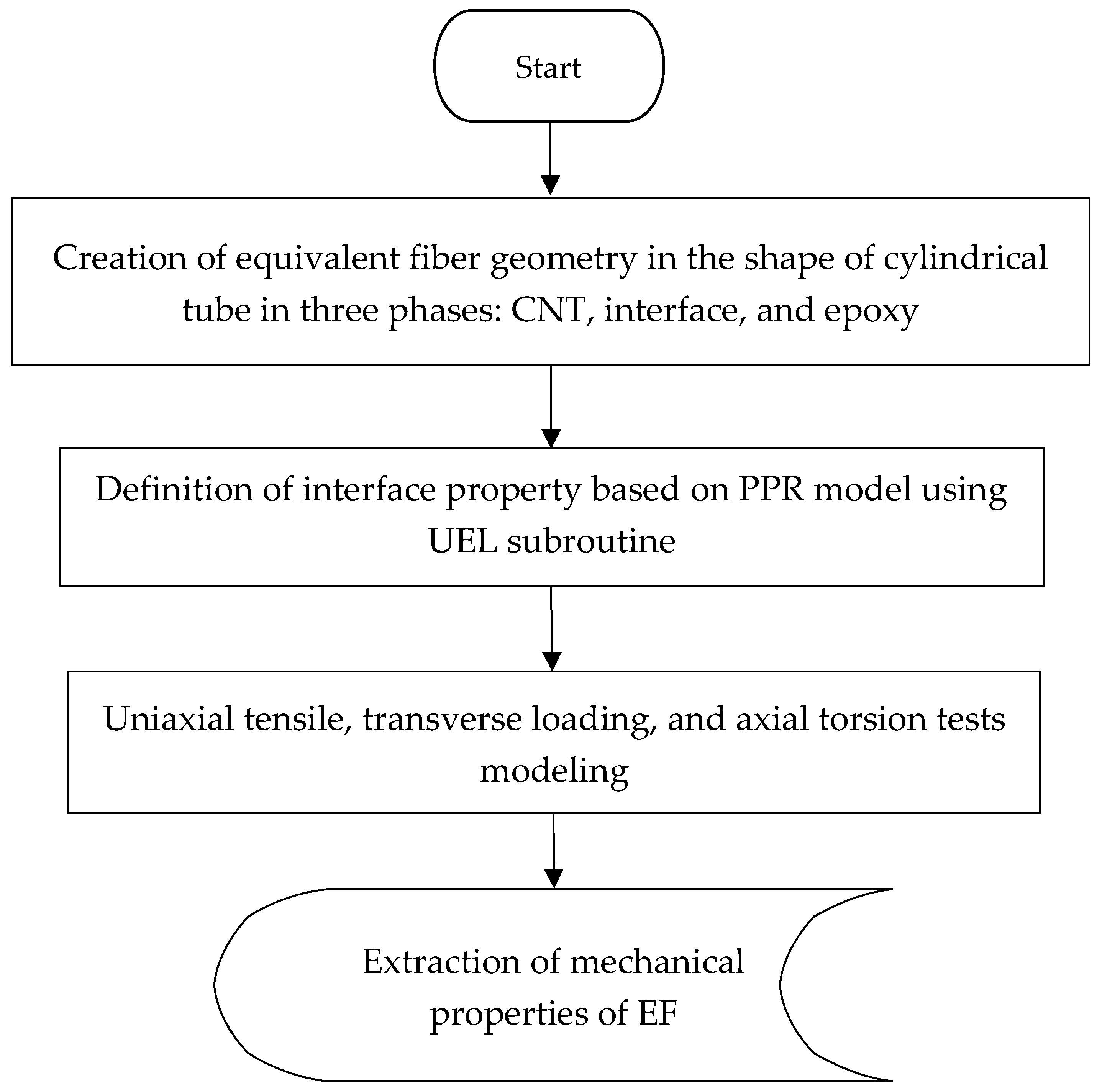
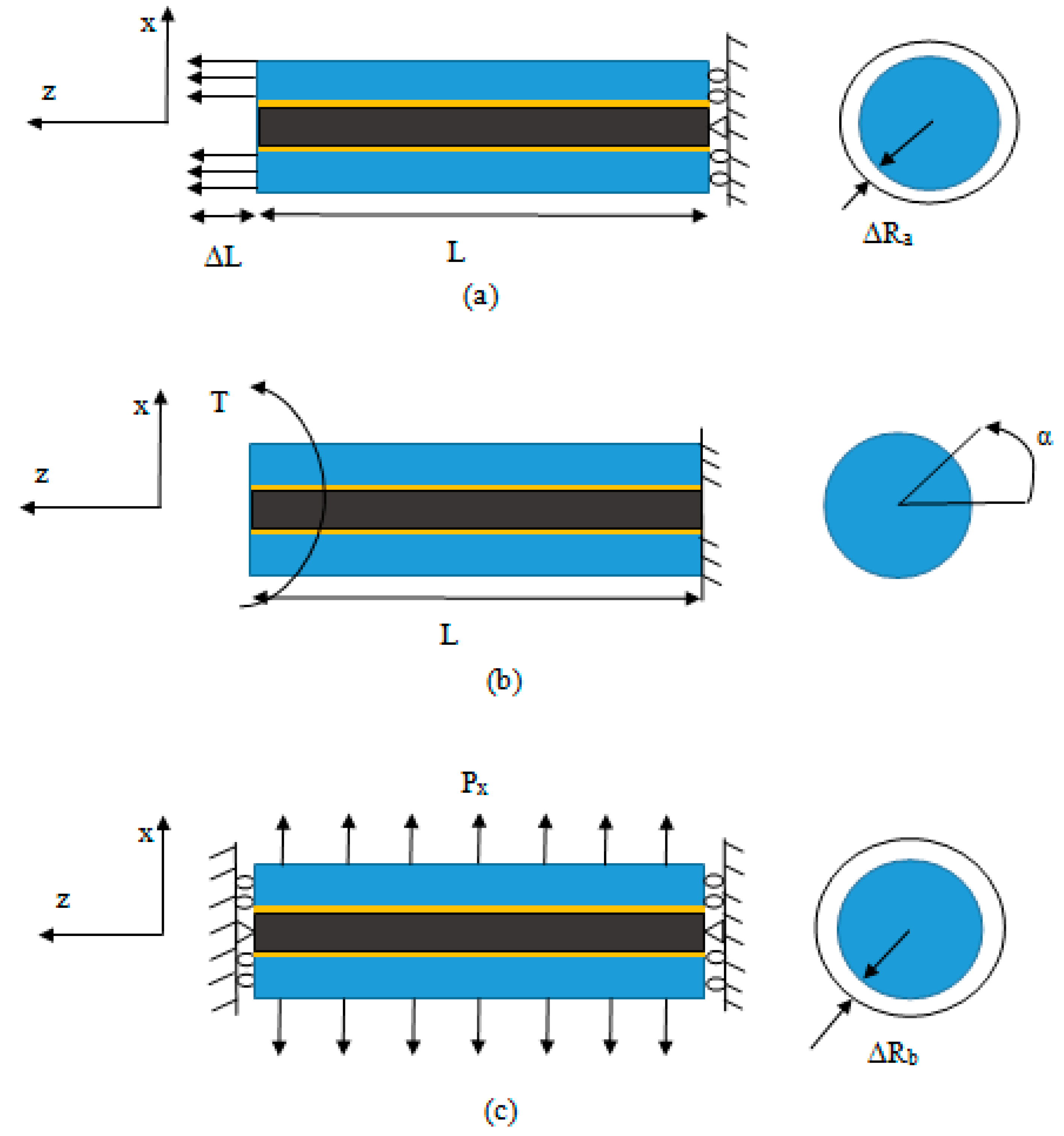
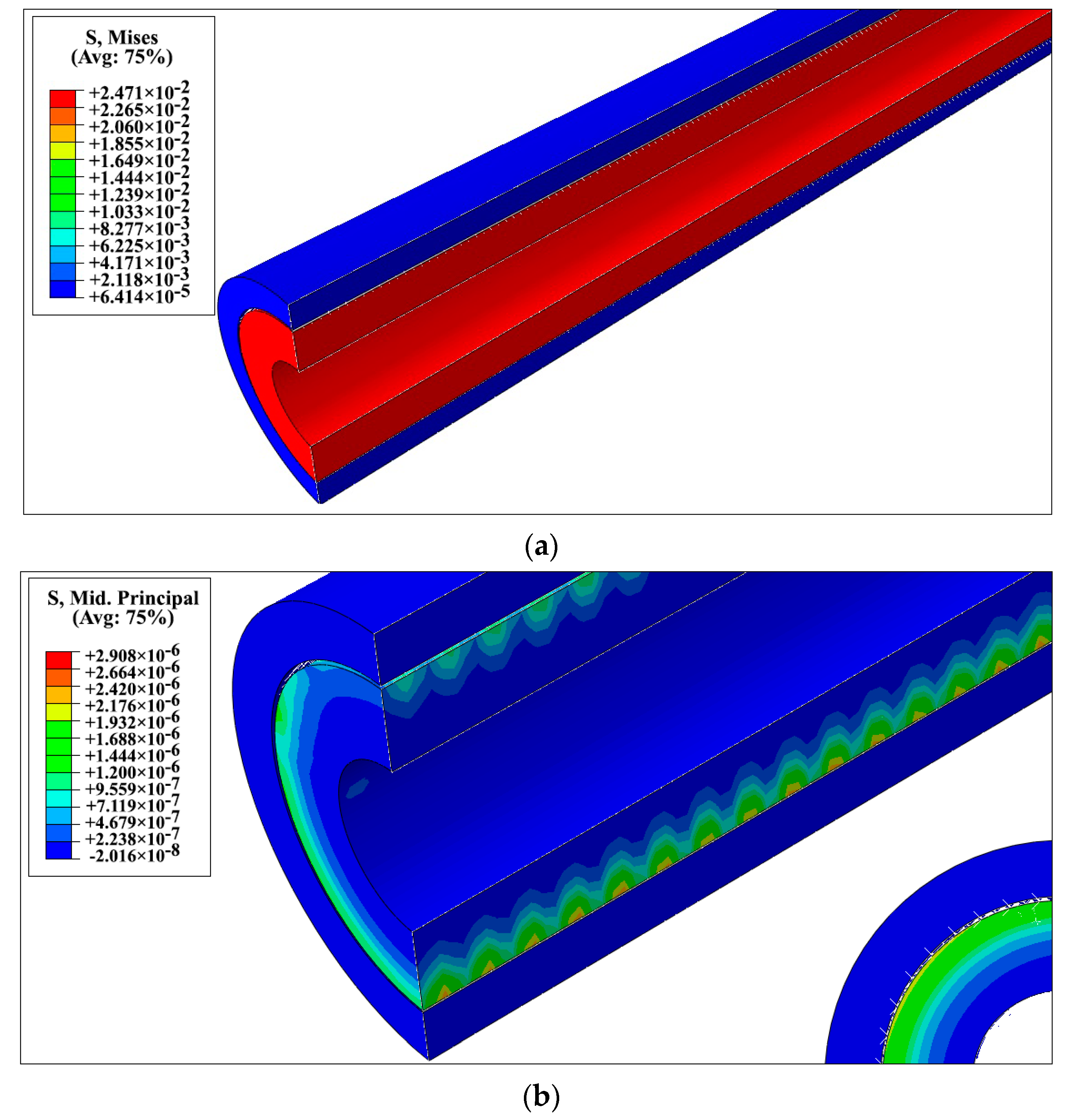

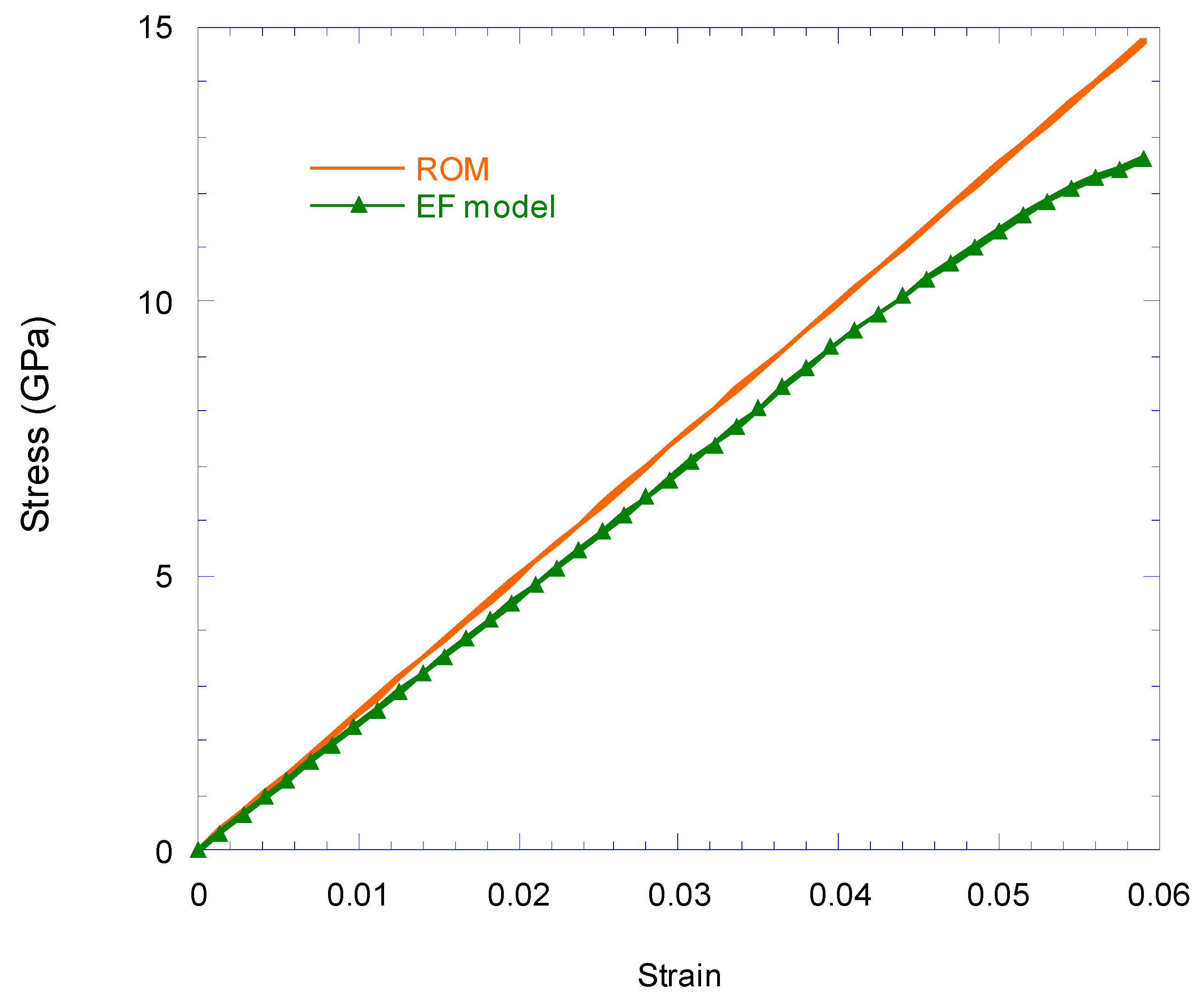
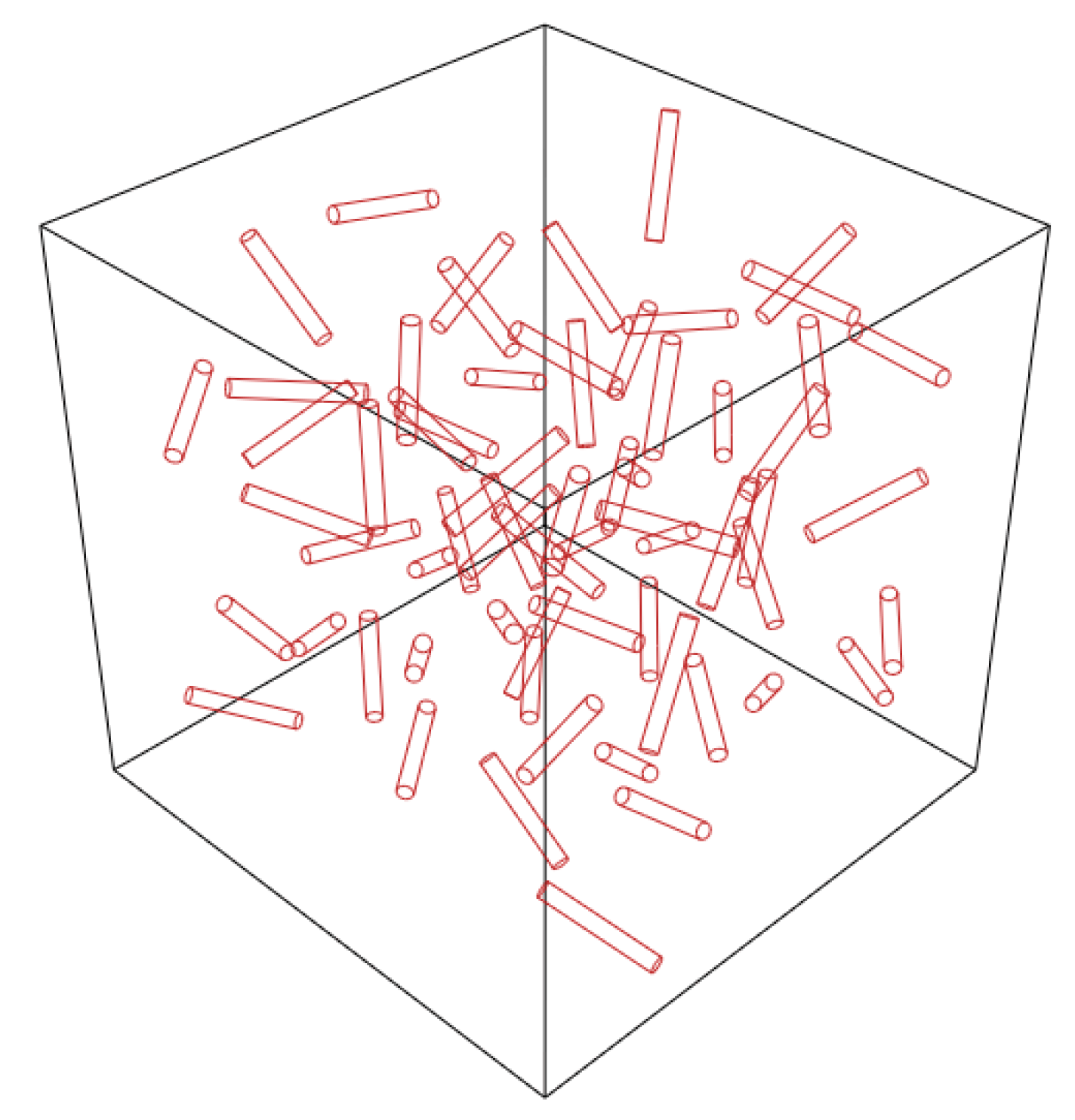
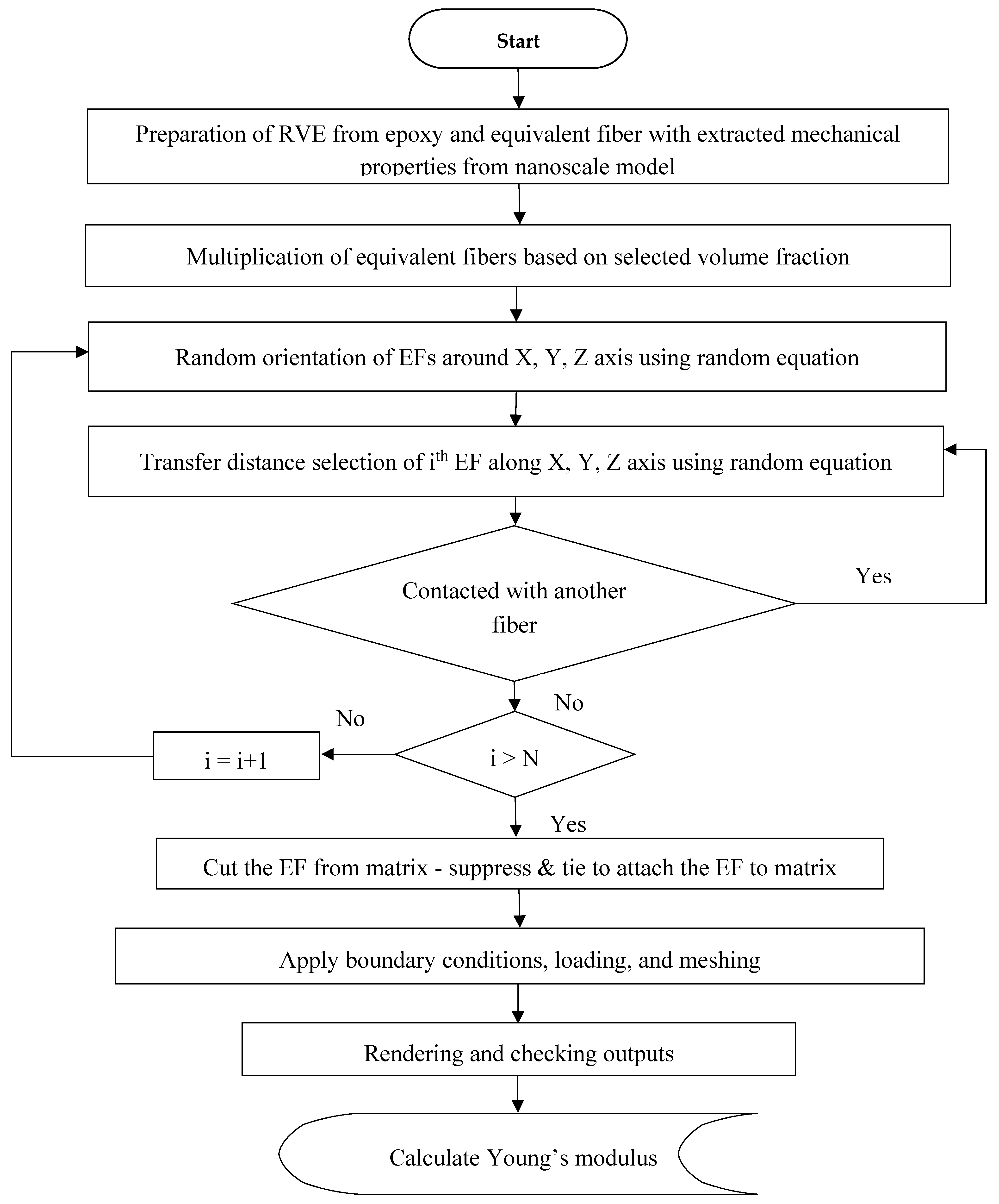
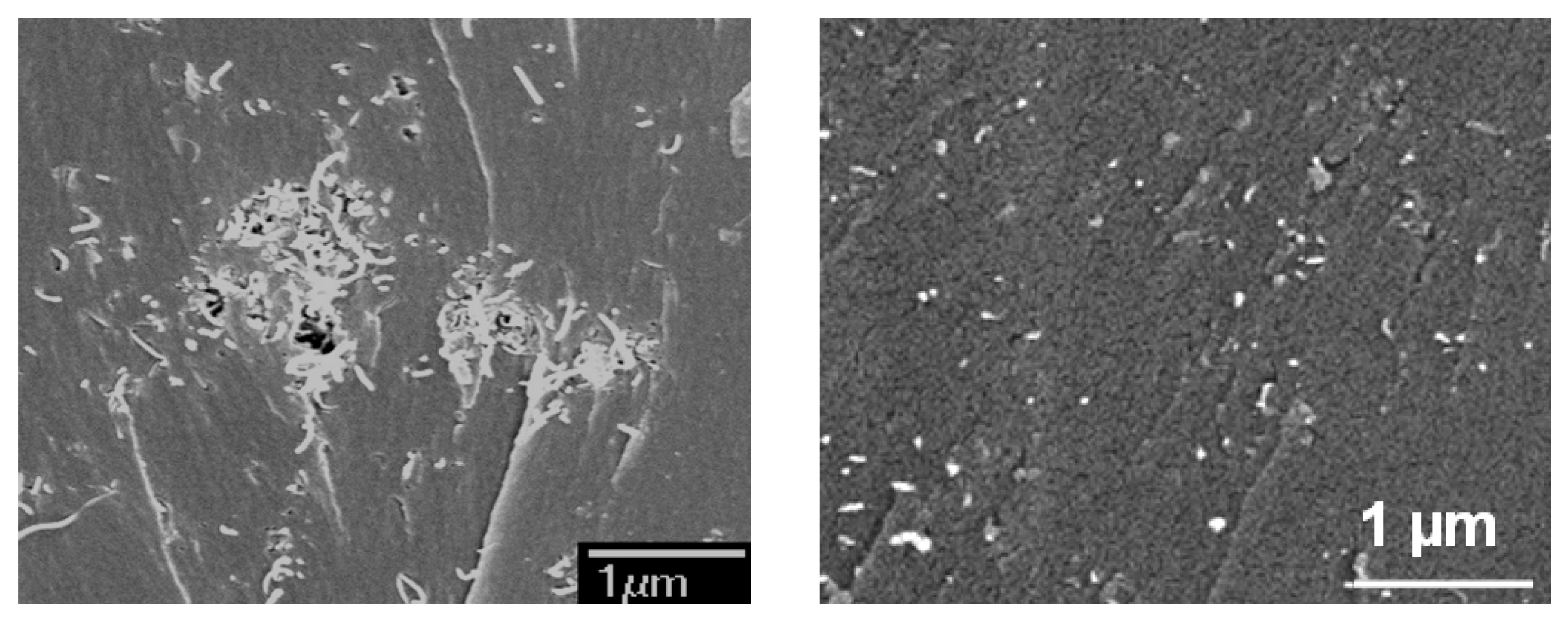
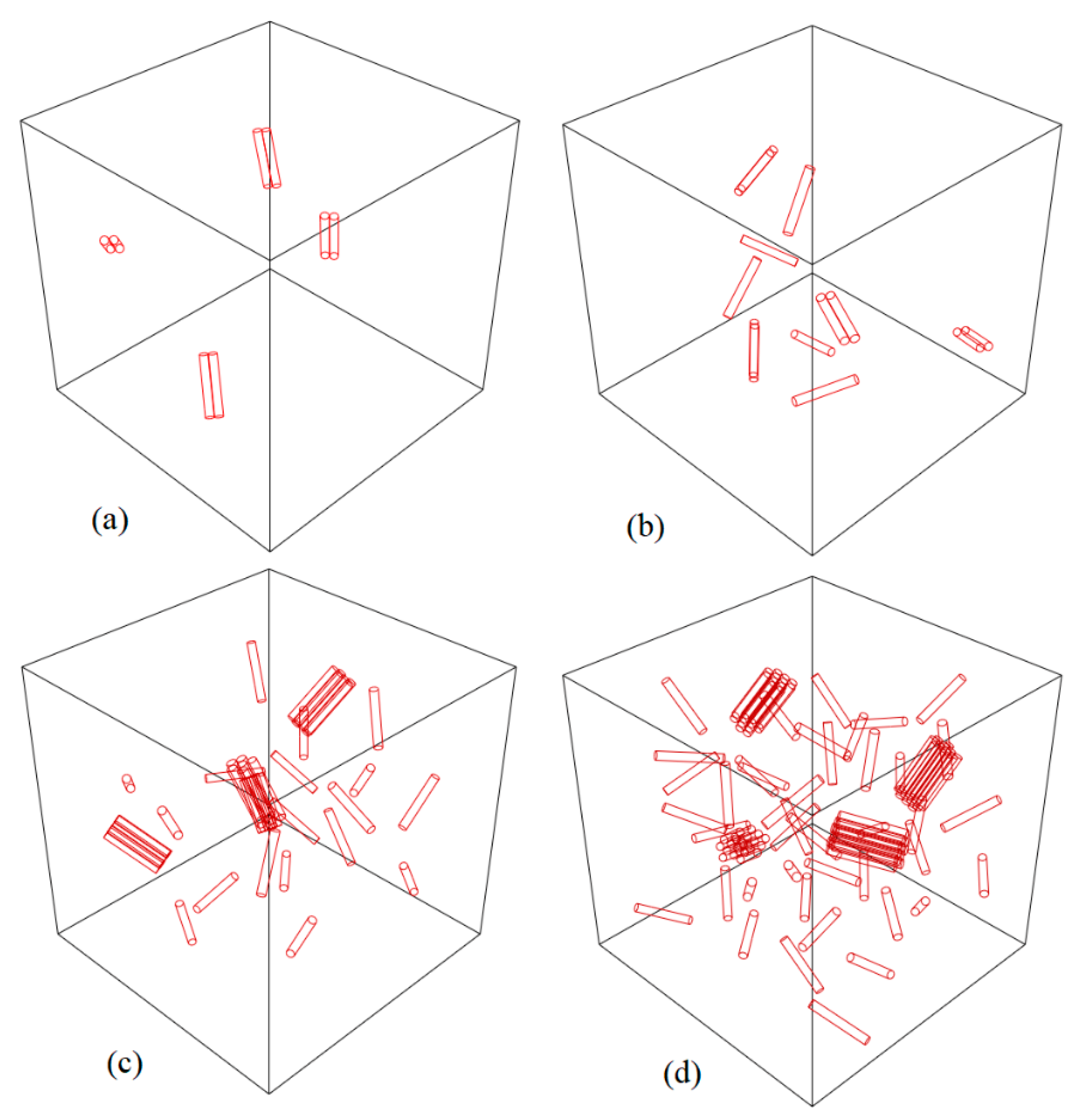

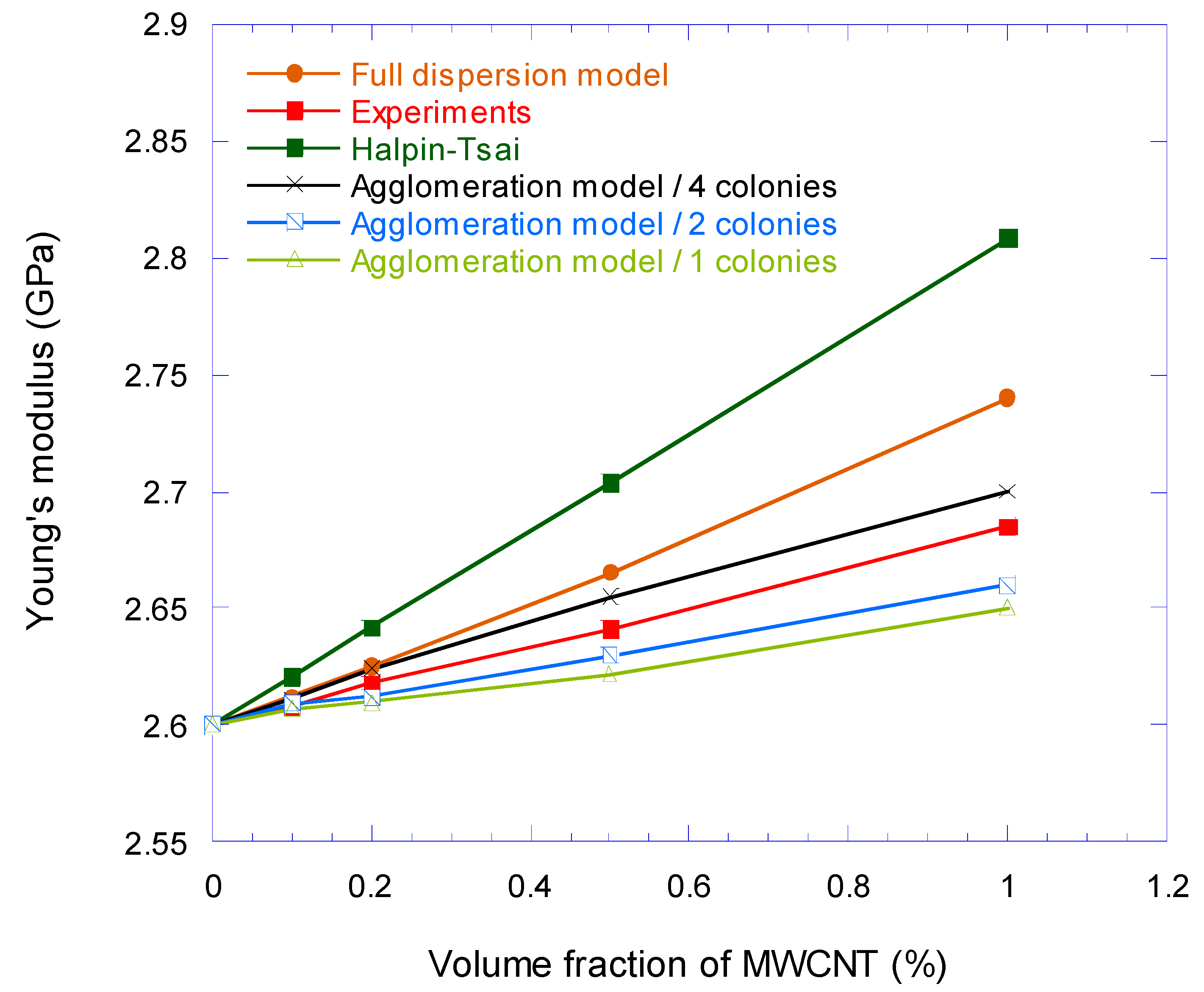
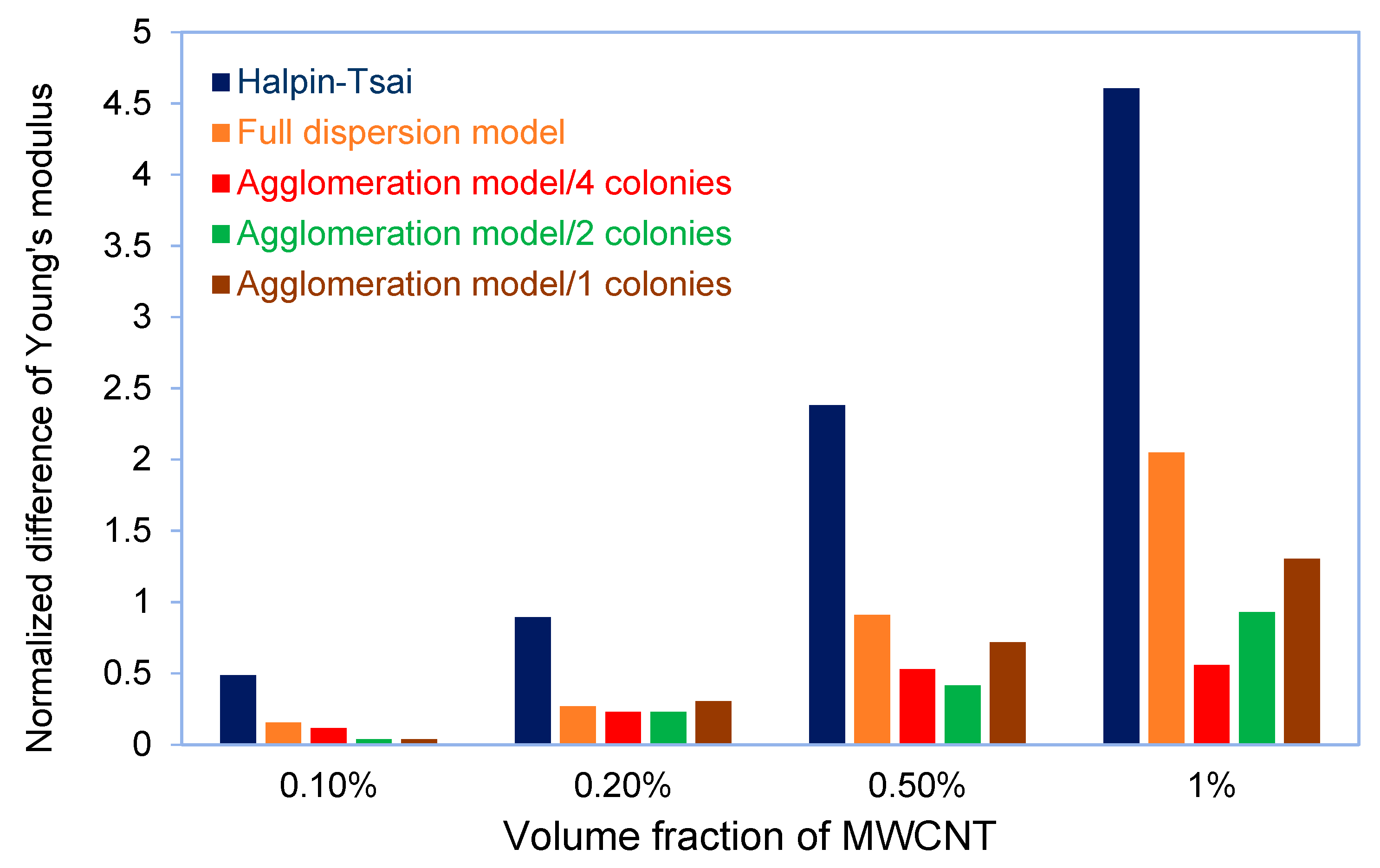
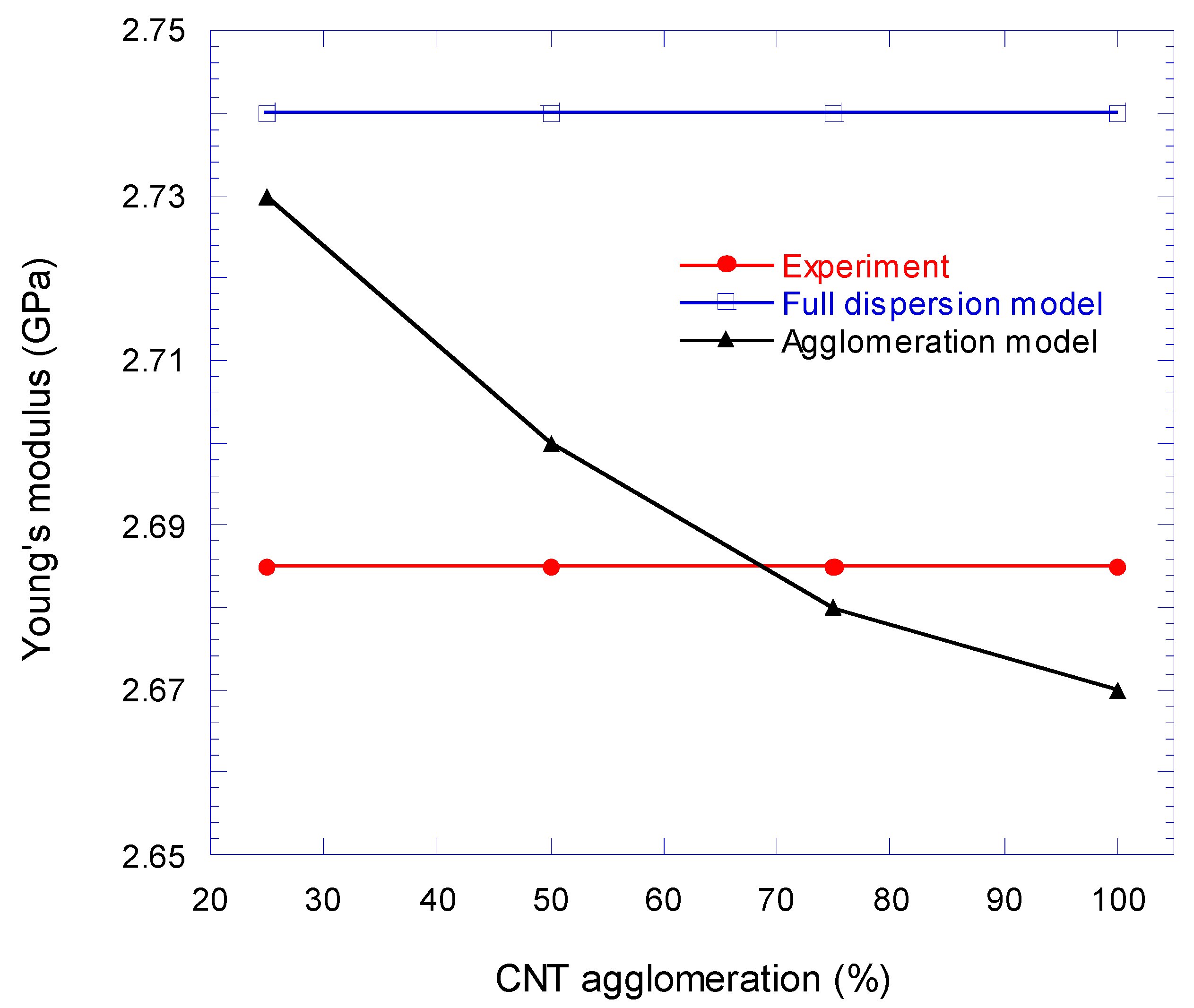
| Value | Input Parameter |
|---|---|
| Fracture energy (N/nm) | |
| Cohesive strength (N/nm²) | |
| α = 5, β = 5 | Shape parameters |
| λn = 0.0851, λt = 0.23516 | Initial slope indicators |
| Transversely Isotropic | |
|---|---|
| Young’s modulus (Ez) | 1 TPa |
| Young’s modulus (Ex = Ey) | 30 GPa |
| Shear modulus (Gxy = Gxz = Gyz) | 30 GPa |
| Poisson’s ratio (νxy = νxz = νyz) | 0.0687 |
| Density (ρ) | 2.1 g/cm³ |
| Acetone (mL) | MWCNT (mg) | Hardener (g) | Epoxy (g) | CNT Vf.% | CNT wt.% |
|---|---|---|---|---|---|
| 30 | 30 | 1.5 | 15 | 0.1 | 0.18 |
| 60 | 60 | 1.5 | 15 | 0.2 | 0.36 |
| 150 | 150 | 1.5 | 15 | 0.5 | 0.9 |
| 300 | 300 | 1.5 | 15 | 1 | 1.8 |
© 2018 by the authors. Licensee MDPI, Basel, Switzerland. This article is an open access article distributed under the terms and conditions of the Creative Commons Attribution (CC BY) license (http://creativecommons.org/licenses/by/4.0/).
Share and Cite
Javadinejad, M.; Mashayekhi, M.; Karevan, M.; Hadavinia, H. Using the Equivalent Fiber Approach in Two-Scale Modeling of the Elastic Behavior of Carbon Nanotube/Epoxy Nanocomposite. Nanomaterials 2018, 8, 696. https://doi.org/10.3390/nano8090696
Javadinejad M, Mashayekhi M, Karevan M, Hadavinia H. Using the Equivalent Fiber Approach in Two-Scale Modeling of the Elastic Behavior of Carbon Nanotube/Epoxy Nanocomposite. Nanomaterials. 2018; 8(9):696. https://doi.org/10.3390/nano8090696
Chicago/Turabian StyleJavadinejad, Mahdi, Mohammad Mashayekhi, Mehdi Karevan, and Homayoun Hadavinia. 2018. "Using the Equivalent Fiber Approach in Two-Scale Modeling of the Elastic Behavior of Carbon Nanotube/Epoxy Nanocomposite" Nanomaterials 8, no. 9: 696. https://doi.org/10.3390/nano8090696
APA StyleJavadinejad, M., Mashayekhi, M., Karevan, M., & Hadavinia, H. (2018). Using the Equivalent Fiber Approach in Two-Scale Modeling of the Elastic Behavior of Carbon Nanotube/Epoxy Nanocomposite. Nanomaterials, 8(9), 696. https://doi.org/10.3390/nano8090696




